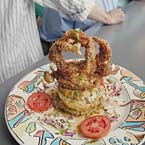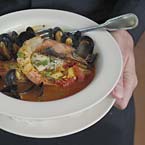The Team Effort that Builds a Great New Orleans Meal



Delicious Culinary Team Creations
Food-lovers from casual tourists to cultural scholars have long been fascinated by the long and winding road that is New Orleans’ distinctive culinary heritage, with its rich traditions and polyglot influences. But when it comes to delivering the goods – to getting that crabmeat-covered trout fillet, that oyster-studded bowl of gumbo and that boozy bread pudding to the table on a busy night in a French Quarter restaurant – a much more linear roadmap takes over.
Like fine restaurants the world-over, New Orleans’ old institutions, hip new destinations and beloved local standbys all rely on a kitchen hierarchy passed down from the French. It’s a system with international celebrity chefs at its apex, like superstar Emeril Lagasse and Cajun master Paul Prudhomme. But at its core, it is a system of dishwashers, expediters, line cooks and managers that are as essential a part of the New Orleans culinary experience as the seafood pulled from local waters and the seasonings that make it sing.
“This is such a competitive market for dining, you have to be on all the time, from procuring the right stuff right up front to getting it to the table promptly,” says Melvin Rodrigue, general manager of Galatoire’s Restaurant (209 Bourbon St., 504-267-2081).
The kitchen here is run by executive chef Ross Eirich, a New Orleans native who enjoyed family dinners at Galatoire’s as a young child. His supporting cast includes kitchen managers, sous chefs, grill men, fry cooks, a sautee line, a position dedicated to cold appetizers, a dessert crew and myriad other players in the grand theater that is a meal at this 100-year-old culinary landmark.
The menu, dining room ambiance and overall experience of Galatoire’s is an only-in-New Orleans phenomenon, but the pecking order of the kitchen would be familiar to a culinary professional almost anywhere. What follows is a top-down look at the hierarchy behind a fine restaurant meal:
Chef de Cuisine – this is the bold face name, the public face of a restaurant and also the person least likely to do any actual cooking. This chef brings the vision and sets the personality of a restaurant, usually conceiving the dishes but more often working the airwaves than the stove. In some cases, a restaurateur’s fame exceeds even this exalted position. For instance, when Chef Emeril enters Nola (534 St. Louis St., 504-522-6652), just one location in his nine-restaurant empire, even his staff here crane their necks for a celebrity sighting. Taking over the role of chef de cuisine here, then, is Michael Ruoss, a native of Maine who started at Nola as a line cook (see below) and quickly worked his way up to the restaurant’s top spot in 2004.
Executive Chef – like executives in other types of business, this chef hires and fires staff, oversees food costs and takes care of all the myriad jobs that make a kitchen a business. Fulfilling this role at another famous New Orleans restaurant, K-Paul’s Louisiana Kitchen (416 Chartres St., 504-524-7394), is Paul Miller, who works as the right hand man to proprietor Paul Prudhomme. Miller hails from Opelousas, La., the same rural Cajun community as Prudhomme, and has worked at K-Paul’s since 1981. Not only does he direct the kitchen of this immensely popular restaurant, but also works with Prudhomme on his company’s food manufacturing operation and catering business.
Sous Chef – the sous, or “under,” chef is the hands-on person who is always at work in the kitchen. Larger restaurants will have several on duty during any given shift. They cook, but also create daily specials, manage kitchen inventory, oversee staff and keep everything moving. The next step for a sous chef is often opening his or her own restaurant.
Expediter – in the dichotomy between the front of the house (waiters) and back of the house (kitchen staff), the expediter becomes the liaison, making sure dishes move from kitchen to dining room as fast as possible and in a coordinated manner. When each guest at a table of six is served simultaneously, you’re seeing the work of an on-target expediter.
Pastry/Dessert Chef – making fine desserts can be a delicate business, so the pastry chef is usually found in the farthest reaches of a kitchen, keeping soufflés and chocolates away from the clamor of the hot stoves up front. At Broussard’s Restaurant (819 Conti St., 504-581-3866), one of the city’s grande dames of Creole dining, a special dessert preparation station is taken out of the kitchen altogether and operates in open view in the restaurant foyer.
Line Cooks – the ground troops of the kitchen, line cooks are the people who do the majority – if not all – of the cooking. Line cooks are assigned by preparation style (for instance, one will run the grill, another the fryer) and by food type, while restaurants with particularly popular items will often devote a line cook to prepare that signature dish exclusively. Aspiring chefs learn their chops as line cooks, usually working their way through each position on their way to becoming a sous chef.
Dishwashers – these may be the positions at the bottom of the kitchen hierarchy but, like the foundation of a house, without them the whole operation would collapse. After all, if the memory of a dirty plate or lipstick-stained glass outshines that of its food, even celebrity chefs could find their spotlights dimming.
Ian McNulty is a freelance food writer and columnist, a frequent commentator on the New Orleans entertainment talk show “Steppin’ Out” and editor of the guidebook “Hungry? Thirsty? New Orleans.”





